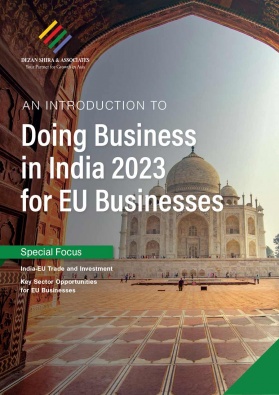India-UK FTA Talks – Where Things Currently Stand
India and the UK are expediting their free trade talks, aiming for a deal by October’s end to secure significant benefits. Leaders of both countries are looking at an election year and this has complicated the last leg of negotiations. There is sufficient goodwill on both sides, and key compromises are being made, but signing the FTA agreement will ultimately be a political decision.
Background
On October 13, India’s Commerce Secretary Sunil Barthwal stated that negotiations for the India-UK free trade agreement (FTA) were in advanced stages. Barthwal visited London this month, followed by a visit from his UK counterpart to New Delhi, indicating mutual interest in moving the discussions forward and resolving pending issues.
However, both Indian and UK government representatives emphasized that the deal would not be rushed, requiring significant breakthroughs. The FTA talks have been largely secretive, despite their fast pace and the involvement of multiple short-lived UK governments.
While there is goodwill on both sides for the India-UK FTA, industry stakeholders have expressed conservative views on contentious issues. These include modifications to protectionist measures for the automotive and beverage sectors, relaxations in the rules of origin (ROO) norms, and ease of cross-border professional and business mobility. Both countries have conservative (right of center) governments facing an election year in 2024, influencing how the final deal will be presented to the public and their respective electoral constituencies.
Status of the talks
Round 13 of the India-UK talks swiftly transitioned to round 14, commencing in New Delhi on October 9. A broad consensus has been reached on 24 out of 26 proposed draft chapters. Depending on the progress of talks, there are discussions in Indian media about welcoming UK PM Rishi Sunak to India on October 28. While not officially confirmed, it is rumored that the 4-day visit may involve the signing of the deal and attendance at the India-England cricket game in Lucknow, scheduled for October 29 during the Cricket World Cup.
Previously in September during the G20 meetings held in India, Sunak told the media that the UK would not agree to any “quick-fix trade deal with India”.
Following this cautious approach, the proposed India-UK Bilateral Investment Treaty (BIT) will be signed later, and negotiations for which remain ongoing. Till such a BIT is agreed to, the India-UK Infrastructure Financing Bridge will address any bilateral issues in investments, per media reports.
Sticky issues and key compromises
The India-UK FTA is poised to become India’s most comprehensive trade deal, with 24 of the 26 chapters having reached either an in-principle agreement or broad consensus.
Remaining areas of negotiation include rules of origin, addressing concerns such as product-specific rules, value addition, chapter headings, and certification. India does not want the UK to be used as a conduit for goods destined for India, which has contributed to its growing trade deficit, reaching US$263 billion in FY 2022-23 from US$191 billion in FY 2021-22.
UK negotiators, in turn, seek a more efficient Indian customs bureaucracy. In terms of intellectual property (IP), pending considerations involve accommodating demands from the UK’s life sciences and biotech sectors and the effectiveness of India’s IP protections.
Disputes also revolve around professional mobility, with the UK hesitant to exceed the current annual quota of approximately 100,000 work visas for Indian nationals. India argues that many skilled professionals in various sectors do not require long-term visas due to shorter assignment durations.
In addition to visa-related concerns and job flexibility for skilled workers, UK and Indian negotiators have forged a “broad understanding” on issues like labor standards and environmentally sustainable business practices.
The free trade deal is stuck on just a handful of issues where a decision would now have to be a political call. If the two PMs decide to settle the matter during Sunak’s visit, we could have the FTA immediately. Otherwise it will go back to the negotiators and it can be anyone’s guess how long it would take to get resolved. One must also not forget next year’s elections in both countries…” – Sources speaking to Business Line
Market prospects for India and UK businesses
India has replaced France as the world’s biggest buyer of Scotch and the Indian whiskey market is set to be valued at more than US$22 billion by 2027. This despite up to 150 percent tariff duty imposed on Scotch imports. Any duty reductions, if passed onto Indian consumers, will convert to higher sales and boost the Scotch Whisky industry in the UK.
Within the context of the India-UK FTA negotiations, which represent a significant opportunity for businesses and industries in both countries, our observations from the last 20 months are particularly noteworthy. We have noticed a distinct trend of British businesses expanding their operations within the Indian market, and we foresee this trend gaining further momentum as this trade agreement continues to progress. – Head of the UK & Ireland Desk at Dezan Shira & Associates, Maria Kotova
Likewise, prospects abound in the automotive sector, where 2022 data shows that the UK exported £270 million (US$327.88 million) worth of automotive goods to India—showing an increase of 11 percent from the year before. India’s automotive exports to the UK in 2022 amounted to £160 million (US$194.30 million), which was a 12 percent increase over 2021. (£1=US$1.21.)
Given India’s ambitions for the electric vehicle segment, UK carmakers are highly keen on the lowering of tariff barriers. According to a proposal from India’s top automotive industry association, the Society of Indian Automobile Manufacturers (SIAM), reported by Reuters in May 2023, the current import taxes of 70 percent and 100 percent on cars could be gradually decreased to 10 percent over a five-year period, but this reduced rate would only apply to a quota, i.e., a maximum of 46,200 vehicles.
India has one of the most protected automobile markets in the world with domestic manufacturers ensuring high tariffs remain in place. It remains to be seen what concessions will be made in the final print of the India-UK FTA.
While India’s tariff on British-made cars is 150 percent and UK spirits is up to 150 percent, the British market has much lower barriers for Indian goods. Many Indian goods exports to the UK have the advantage of low or zero tariffs. India’s simple average tariff on imported goods from the UK is 14.6 percent.
This gap underlines certain facts in the India-UK trade relationship, as highlighted by a recent report from the Global Trade Research Initiative (GTRI). Per the report’s findings, “While textiles, apparel, footwear, agricultural products and certain other items stand to benefit from tariff reductions, substantial growth in Indian exports to the UK will ultimately hinge on product quality improvements rather than the FTA alone”.
Thus, India’s labor-intensive industries need to modernize to meet the quality thresholds of the UK market. In this regard, British investors and manufacturers will find various commercial opportunities in the Indian landscape for industry innovation, capacity upgrades, local sourcing, and related commercial prospects. There are multiple production-linked incentive schemes implemented in India that seek to create an industrial ecosystem for niche products and higher value goods in mature sectors—from textiles, electronics, and automobiles to pharmaceuticals, medical devices, and drones.
India-UK Trade and Investment: A Snapshot
India-UK bilateral trade increased to US$20.36 billion in 2022-23 from US$17.5 billion in 2021-22. During the April-June period, India’s exports to the UK were primarily propelled by aviation turbine fuel, contributing US$324 million, followed by smartphones at US$292.5 million and wallpapers at US$147.2 million.
The top five UK goods exported to India in the four quarters to the end of Q1 2023 are non-ferrous metals (£2.9 billion), metal ores and scrap (£1.2 billion), mechanical power generators (intermediate) (£0.6 billion), beverages (£0.3 billion), and scientific instruments (capital) (£0.2 billion).
The UK is the sixth-largest investor in India, with foreign direct investment (FDI) inflows amounting to US$34.29 billion from April 2000 to June 2023. Currently, there are 618 UK-based companies in India, collectively generating a turnover worth approximately US$45.6 billion as of 2022. British investment in India spans various sectors, in particular, education, retail, consumer goods, life sciences, healthcare, and infrastructure.
Conversely, India is the second-largest contributor of FDI to the UK. Over 954 Indian companies actively operate in the UK, with combined revenues of approximately US$65 billion, per Invest India data.
About Us
India Briefing is produced by Dezan Shira & Associates. The firm assists foreign investors throughout Asia from offices across the world, including in Delhi and Mumbai. Readers may write to india@dezshira.com for more support on doing business in India.
We also maintain offices or have alliance partners assisting foreign investors in Indonesia, Singapore, Vietnam, Philippines, Malaysia, Thailand, Italy, Germany, and the United States, in addition to practices in Bangladesh and Russia.
- Previous Article Understanding the Global Biofuel Alliance and India’s Role Within It
- Next Article Strengthening India-Indonesia Economic Ties: Trends and Prospects









